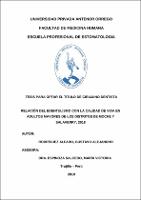Relación del edentulismo con la calidad de vida en adultos mayores de los distritos de Moche y Salaverry, 2018.

View/
Download
(application/pdf: 2.264Mb)
(application/pdf: 2.264Mb)
Date
2019Author(s)
Rodríguez Alfaro, Gustavo Alejandro
Metadata
Show full item recordAbstract
Determinar la relación del edentulismo con la calidad de vida en adultos mayores de los distritos de Moche y Salaverry, 2018.
Material y Método: El estudio fue de corte transversal, se evaluó a 92 adultos mayores. Se empleó Test de OHIP para determinar la calidad de vida y clasificación de Kennedy para determinar la pérdida dental.
Resultados: Se encontró según Kennedy que el mayor porcentaje de edentulismo fue en maxilar inferior (16%) en Clase I-M1. Según calidad de vida se encontró en nivel moderado (72%). Según enfermedad sistémica, fue en maxilar inferior en Clase I-M1 en pacientes con hipertensión siendo moderado (12%) en calidad de vida. Según grado de instrucción, fue en maxilar superior en Clase II-M2 (7%) y maxilar inferior en Clase I-M1 (7%) con primaria completa, presentando impacto moderado en calidad de vida. Según edad, lo obtuvo el maxilar superior en Clase II-M2 (11%) en pacientes con 71-81 años, presentando impacto alto.
Conclusión: Si existe relación entre edentulismo y calidad de vida. To determine the relationship of edentulism with quality of life in older adults in the districts of Moche and Salaverry, 2018.
Material and Method: The study was cross-sectional and 92 elderly adults were evaluated. The OHIP Test was used to determine the quality of life and the Kennedy classification to determine tooth loss.
Results: According to Kennedy, it was found that the highest percentage of edentulism was in the lower jaw, which presented 16% in Class I-M1. According to the quality of life, it was found at a moderate level (72%). According to systemic disease, the highest percentage was in the lower maxilla in Class I-M1 in patients with hypertension, being moderate (12%) in their quality of life. According to educational level, the highest percentage was in the upper jaw in Class II-M2 (7%) and lower jaw in Class I-M1 (7%) with complete primary, presenting a moderate impact on their quality of life. According to age, the highest percentage was obtained in the upper maxilla in Class II-M2 (11%) in patients aged 71-81 years, presenting high impact
Conclusion: If there is a relationship between edentulism and quality of life.
Subject
Collections
- Estomatología [653]

